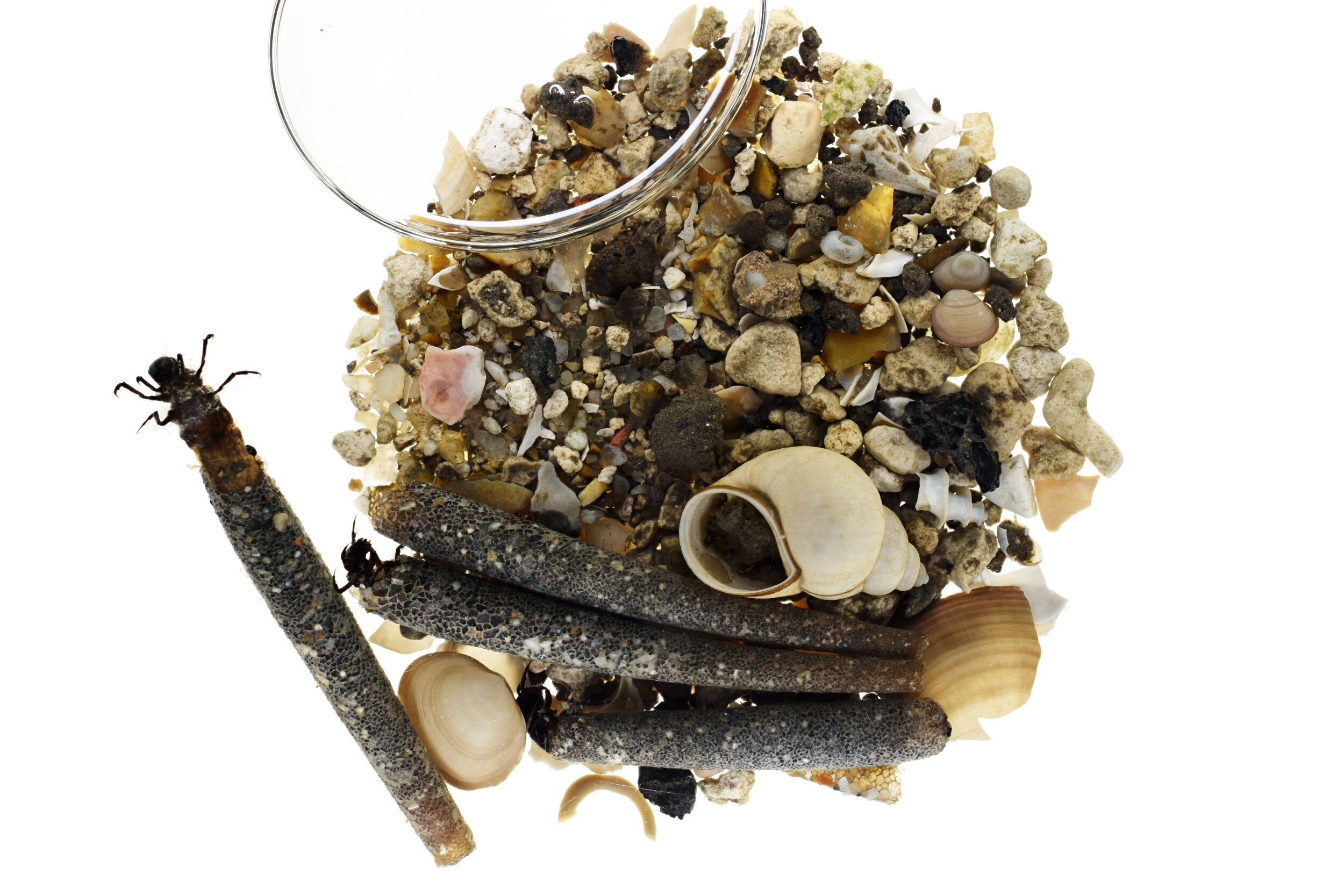Caddisfly larvae make their cases using natural materials they gather around them in their habitat.
What is a Caddisfly?
The caddisfly is a clever creature from the insect order Trichoptera. The adults are moth-like, but it’s their aquatic larvae which are famous for the protective homes they build themselves while in their vulnerable state. They are also known as sedge-flies, rail-flies or “rock rollers” describing their tumbling tubes when they are found in their cases.
Adult Caddisfly
Caddis case protecting the soft vulnerable body of the larvae allowing it to feed more safely.
Caddisflies have been around for at least 250 Million years proven by the finding of fossils in rocks dating back to the Triassic period. There are around 200 different caddisfly species in Britain alone. They are found today all over the world in lakes, ponds, rivers, streams and other bodies of freshwater. There is also a land caddis, which lives in the damp litter of the woodland floor which can be found in oak woods around Worcestershire.
Caddis cases have specific forms of construction and materials depending on the family.
Being soft bodied little grubs, they need to make their own armoured casing, which also serves as camouflage hiding and protecting them from predators. They create their own silk, (similar to the silk work) and in fact their name may possible originate from the word cadyss, being used in the fifteenth century for silk or cotton cloth, and "cadice-men" who sold these materials, which I love whether it’s true or not. Returning to the insect caddis, they use their organic silk to make their protective cocoons by binding together organic materials they gather from around them. Their special aquatic use of silk is also being studied for science and medicine due to its reliably “sticky” properties in wet conditions. A similar material could be used like an internal sticking plaster or tape for surgical incisions instead of sutures.
A caddis case made of leaf fragments specially gathered and shaped by the caddis larvae
Different families of caddis have their own recognisable cases using their preferred materials and distinct structural shapes. Some case makers are fixed in position “retreatmakers”, being made from heavier materials or attached to other natural objects and can use a silk net to catch food. Other caddis casemakers build their mobile home and then drag it along with them underwater as they forage for sustenance. They can also build extensions as they grow larger within them and use them to catch their food. They can use grains of sand, fragments of rock, pebbles, bark, twigs, leaves, seeds and mollusc shells arranged in various formations.
By incorporating local materials a caddis case almost invisible amongst the pebbles
“Pebble dashed house” of a Caddisfly larvae
The way this caddisfly larvae binds together small pebbles and grains of sand and stones is reminiscent of pebble dashed houses, or variations such as harling or roughcast. This encrusting technique was thought to provide extra protection to homes, especially in harsh weather areas of Scotland, with different techniques providing better results than others. These pebbles or chips were popular decorative coatings during the arts and crafts movement. Seen as a traditional technique, it brought a natural texture to made buildings. For the larvae the hard stones also provide extra strength and helps it blend in with the rest of their surroundings.
A sculptural composition of a real Caddis case attached to twigs and shell.
Pebbles and shells have always fascinated us, collected, traded and prized to be used as currency or art objects. Their organic shapes have inspired countless artists from their natural structure or weathered surfaces. I find the way the Caddisfly larvae makes their own constructions from these materials very artistic. They do so intuitively, each family will have their own recognisable methods and materials and due to the natural materials, no two cases will ever be alike.
Beautiful composition, courtesy of a clever caddisfly larvae
I have written before about the artist Hubert Duprat and his “collaboration” with Caddisflies. I have been lucky enough to see the cases several times in different exhibitions such as the Dries van Noten exhibition in Paris at the Musée des Arts Décoratifs.
Hubert’s project idea was to control the environment of these caddis larvae so that their materials would be extra special. Instead of the usual twigs, pebbles and leaf fragments they might find in a pond or lake, Hubert filled a tank with golden nuggets, pearls and precious stones. The use of precious materials brings our attention to these clever creatures, but these materials would be useless to them in their real environment, being far too conspicuous amongst the pond weeds and organic debris.
A photo I took of Hubert Duprat’’s caddis cases displayed with a video of the process.
Here are some of my first Caddis inspired rings, you can find more in my online shop, direct from my studio. For me, the caddis symbolises many things; protection and strength, harmony with nature and your surroundings, and an instinctive joy of craft. I have always loved these creatures and have made work inspired by them before, but my fascination was re-ignited whilst researching for a project brief I was given about armour and I haven’t stopped since.
The caddisfly photos in this post are courtesy of The Natural History Museum in London and are of the Mosely Collection of Caddisfly specimens preserved in special liquid under watch glass like mini pools. I look forward to sharing my amazing experience here this year where I was able to study their collection of specimens up close, and delve a little deeper. Coming up in one of my next posts…











